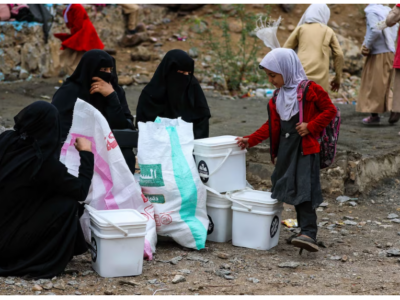
Screenshot from the film Le Camp de Thiaroye
On December 1, 1944, an unspeakable tragedy took place at the military camp of Thiaroye, a small village in the suburbs of Dakar. Thirty-five Senegalese Tirailleurs were killed according to official records, but other testimonies reported more than 300 dead, gunned down by colonial troops after protesting to be paid for their military service (translation note: tirailleur translates to rifleman or sharpshooter). The general public did not learn of this tragedy until 1988, when Senegalese cineaste and writer Sembène Ousmane's film Camp de Thiaroye produced by Senegal and Algeria, was released. This massacre is symptomatic of the French colonial power’s contempt for the African soldiers who had fought for its liberation during World War II. The film was banned in France for 17 years before being becoming available on DVD in 2005.
The Facebook page Massacre du 1er Décembre 1944 : CAMP DE THIAROYE (Massacre of December 1, 1944: CAMP THIAROYE) was created to honor the African sharpshooters: victims of a massacre by their metropolitan army comrades with whom they had fought the Nazi enemy. The course of events is recalled:
On December 1, 1944, African soldiers, liberators of France, were massacred by… France itself. These African servicemen, commonly known as the Senegalese Tirailleurs, had committed one crime: that of being African.
Indeed, how else could the assassination they suffered be explained? These African Tirailleurs*, who mostly had been recruited by force and who had repeatedly been told that France is the motherland, fought the Nazi enemy with conviction and finally triumphed. They were proud of that victory and were afterwards demobilized, arriving at Camp Thiaroye* in Senegal on November 21, 1944. In spite of four long years of absence, the trauma of war, and the loss of their many comrades who perished in combat or were shot by the Nazis, their faces shone with happiness to finally be reunited with their families. They did not suspect that they would never again see their loved ones or home countries, for those originating from other parts of the continent. There were 1,280 of them, coming from all over French West Africa.
On November 30, 1944, however, there was a revolt at Camp Thiaroye. It came about after they demanded to be paid their salary arrears and demobilization allowance, which had already been denied to them in France before they returned to Africa. They thus took General Damian as hostage. The night of December 1, 1944, the battalion of Saint-Louis stormed the unarmed camp without warning. There were about 30 survivors who were condemned to one to ten year prison terms, fined, and denied their mobilization pay. They were only released in 1947, by the then French president Vincent Auriol. They were not restored their rights and were not entitled to a retirement pension.
Léopold Sédar Senghor, one of the rare public figures to have denounced this colonial crime, dedicated a poem to the victims in December 1945 and wrote an article on their subject in the July 1945 issue of the review Esprit. In contrast, the French administration at the time tried to minimize the contribution of these soldiers in an effort to avoid paying what it owed them, before finally killing them. The Comité de Vigilance face aux usages publics de l’histoire (Vigilance Committee on the Public Use of History), in a letter and petition addressed to President François Hollande, broke down the lies of the state and denounced the attitude of the French authorities in this affair:
Stripped of their rights.These men had fought for France and demanded to be paid for their time as POWs. Their request had been refused by the Dakar military authorities, which was a transgression of the regulations at the time.This despoliation was covered up by the then Ministry of War. It falsely stated in a circular dated December 4, 1944 – thus after the massacre – that the repatriated soldiers had received the totality of their compensation before their departure from France.A massacre premeditated and concealed.Aiming to silence the legitimate claims of these men, an operation of the armed forces was mounted to crush/diminish the rebels. To conceal the massacre, certain officers produced damning reports and fabricated an official account of a mutiny. In these reports, the ex-prisoners of war are described as being paid by the Germans and heavily armed. In order to justify the heavy response, they were accused of being the first to shoot.
The shooting began shortly after 9:00am, but what followed isn't clear. The reports are so contentious that the historian has to become a sort of detective. Testimony written by Lieutenant-Colonel Le Berre diverges from that of Battalion Chief Le Treut, Captain Olivier, Colonel Carbillet, General Dagnan, Lieutenant-Colonel Siméoni, Gendarmerie Lieutenant Pontjean, Colonel Masle, or General de Perier, who initiated a commission of inquiry in 1945. Certain circulars and reports are nowhere to be found. “They’ve disappeared,” explains the historian, who explored the various centers where the documents of the time are preserved, in France and in Senegal.
Successive accounts communicate the idea of a response to machine or submachine gunfire from the mutineers. General Dagnan had a list made of the weapons allegedly found. Armelle Mabon had this list examined by experts from the Union française des amateurs d’armes (French Association of Arms Enthusiasts). Something doesn’t add up in this inventory, and the response to it – a tank, two half-track vehicles, and three armored cars – is totally unjustified.
Officially, 35 sharpshooters were killed on December 1, the figure used by François Hollande in his speech in Dakar. Twenty-four were reported to have died during the attack and eleven at the hospital. But General Dagnan’s December 5 report cited “24 killed and 46 wounded transported to the hospital and deceased thereafter,” for a total of 70 victims. “What could he have stood to gain by overstating the number of deaths?” asks the historian, who gives credence to this last figure.
We still don't know where they are buried, probably in a mass grave nearby or in the small, forgotten military cemetery of Thiaroye. Jean Suret-Canale was one of the very first to evoke this episode in Tome II of his Histoire générale de l’Afrique occidentale (1963). I heard about it towards the end of 1970 from some Senegalese friends who had a vague idea of what had happened. I went looking for the cemetery but had trouble finding it, since no one knew where it was. It was hidden behind a small wall not very far from the road heading towards the Petite Côte. Today it has been restored and is well maintained.



